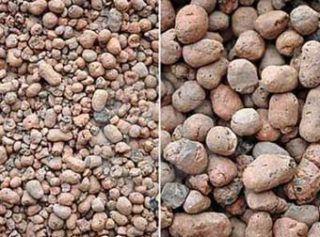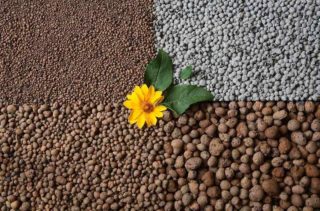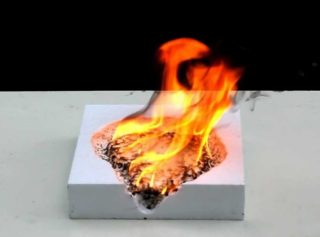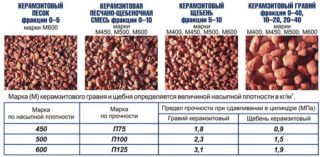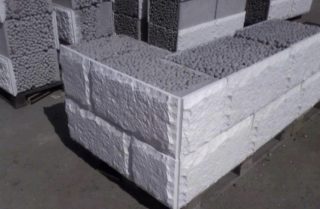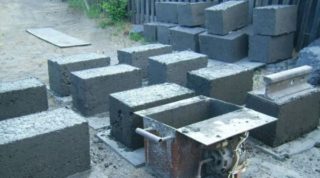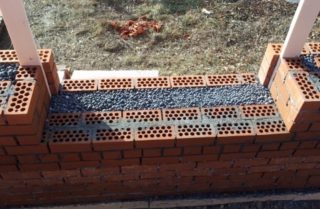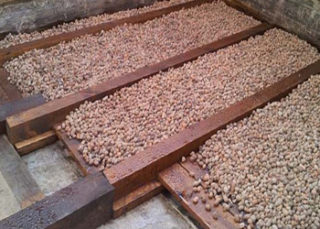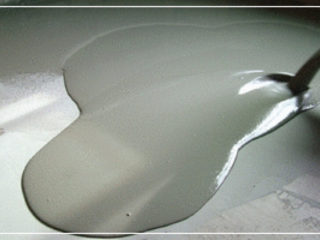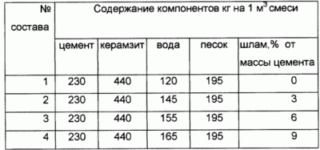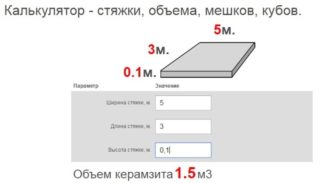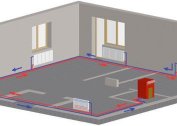When choosing insulation materials, you need to figure out why expanded clay is used, how to work with it. Universal gravel fractions are used in construction, for the decoration of a house or garden. Lightweight clay-based material is characterized by good sound insulation and heat saving, therefore it is suitable for backfilling under the foundation or in the frame wall.
Production technology
Expanded clay is obtained from shale rocks, calcined at a temperature of from 1200 to 1300 degrees. Melting technology allows you to make rough brown granules with pores that look like gravel. Dry, wet, plastic and powder-plastic methods are used. One batch of products is completely manufactured in 40 minutes, after which it cools and calibrates in size. If necessary, the material is crushed.
Expanded clay grains, depending on size, are divided into the following types:
- Gravel - has fractions of 5-10, 10-20 and 20-40 mm. The shape of the product is spherical, slightly expanded.
- Crushed stone - the size of the fractions is similar to gravel. The difference lies in the angular shape resembling a stone.
- Sand - fine-grained grains from 5 mm in size.
Most often produce round or oval expanded clay.
Specifications and material properties
GOST 9757-90 specifies the characteristics of the material, depending on the density. This indicator is from 200 to 800 kg / m3. The density is also determined by the brand. Other indicators are determined by the size of the fractions and are presented in the table.
| Characteristic | Fraction size, mm | ||
| 10-20 | 5-10 | 0-5 | |
| Strength grade | M400-M450 | M500-M550 | M600-M700 |
| Bulk density, kg / m3 | 280-370 | 300-400 | 500-700 |
| Weight loss at 20 freezing cycles,% | 0,4-2 | 0,2-1,2 | – |
| Thermal conductivity, W / mK | 0,0912 | 0,0912 | 0,1099 |
| Moisture absorption level, mm | 250 | 250 | 290 |
| The activity of natural radionuclides (specific), Bq / kg | 270 | 270 | 290 |
Technical parameters explain the expanded clay properties:
- resistance to temperature changes, fire (class NG) and freezing;
- ecological cleanliness - thermal insulation does not decay, does not cake and does not deform;
- high strength, chemical inertness and resistance to acidic environment;
- the possibility of use as a decorative material and insulation;
- good indicators of sound and heat insulation;
- light weight - provides ease of transportation.
The material reduces heat loss at home by 50-75%.
Advantages and disadvantages of expanded clay
Excellent operational characteristics provide the ability to use expanded clay in landscape design, for construction and other works. The advantages of clay grains include:
- universality - can be used for laying on the floor, roof or other structural elements;
- low thermal conductivity - due to internal pores, the granules retain heat well;
- Duration of operation - ceramics, subject to the rules of operation, retain their properties for 40-60 years;
- chemical inertness - clay balls are not destroyed when exposed to alkalis and acids;
- fire resistance - the material does not melt, does not burn;
- A worthy indicator of sound insulation - due to the filling of pores with air, an effective obstacle to sound waves is created;
- resistance to low temperatures - balls with an integral shell structure are not subject to destruction in frost;
- biological stability - rodents do not live in the insulation, mold and fungus do not appear;
- ecological purity - the clay product does not contain allergens, does not emit toxins when heated;
- ease of installation - due to flowability, fractions are placed on a site of any configuration.
Builders note several minuses of expanded clay grain. The frost resistance property is lost by granules with a damaged shell, and laying is complicated by the performance of waterproofing works.
Comparison of expanded clay and expanded polystyrene
To insulate the floor, you can buy expanded clay or polystyrene at an inexpensive cost. Budget materials are similar in ease of installation, but have several differences:
- Moisture is removed from the porous balls, and the foam in a wet environment rots or blackens.
- During fires, clay fractions do not burn, the foam sheet emits toxic toxins.
- The porous structure allows the polyurethane foam to “breathe” like expanded clay, but also accelerates its ignition.
- Polyfoam, unlike expanded clay materials, does not insulate screed - it is more difficult to lay.
Extruded polystyrene is also a competitor to expanded clay, as builders note that a strong synthetic base is better than brittle clay. In general, building materials are similar - they do not emit toxic chemical compounds, are suitable for rooms with a humid environment, are biologically stable, and resist combustion reactions. The differences between them are as follows:
- the possibility of coloring the extruded profile with primers;
- scope - roof, floor and external walls are insulated with expanded polystyrene, expanded clay balls - floor, floors and roof;
- susceptibility to mold formation - low vapor permeability excludes aeration of external walls with polystyrene foam thermal protection;
- reduction of usable area - to insulate the building with expanded clay, you will have to donate 50 cm along its perimeter.
Polyfoam and polystyrene need to be cut, and expanded clay granules just pour out, which reduces the time of work.
Varieties of Ceramic Grain
The material is classified by grain size. Based on this, it is divided into 3 categories.
Sand
Granules with a size of not more than 5 mm, made by crushing large pieces of baked clay or by burning the remnants of the initial raw material. Fine-grained expanded clay can be used as a filler for ultralight concrete or cement mix.
Gravel
Rounded grains of 5-40 mm in size produced by expanding a clay billet in a blast furnace. Thanks to good thermal insulation performance, it is possible to use concrete blocks as a heater or manufacture.
Crushed stone
Elements with corners, large - from 5 to 40 mm. Production is carried out by crushing ceramic layers. Material - a filler necessary for lightweight concrete.
Features of the use of expanded clay granules in heating
Expanded clay can be used as an insulating building material for floors made of wood or concrete, attic, roof, ceiling, walls, interfloor structures. Pellets can protect not only the house from heat loss, but also bath structures or the foundation. It can be used in bulk or in the form of blocks.
Block making
The process involves the preparation of expanded clay mixture from clay balls, cement, sand and plasticizer additives. The recipe should count on 1 cubic meter of solution. As a result, you will need:
- 230 kg of cement M400;
- 600 kg of quartz sand with fractions of 2-2.5 mm;
- 190 kg of water;
- 600-760 kg of expanded clay gravel with fractions of 5-10 mm.
The output is concrete M150, which is suitable for wall structures. If necessary, a 10% aqueous solution of bitumen mastic is added to the mixture.
For the manual production of blocks, you will need a vibrating machine or concrete mixer, molds and shovels. The form can be made of boards, plywood or iron, cutting them into blocks 19x18.8x39 cm or half blocks 9x18.8x39 cm. The technological process is carried out in stages in a well-ventilated room:
- The manufacture of the solution. Cement is poured into the concrete mixer and water is poured. The remaining components are added portionwise.
- Pouring the mixture into molds. It is carried out portionwise, 2 spades. Each layer is distributed and compacted.
- Pre-drying. Containers with concrete dough are covered with metal lids and left for 24 hours.
- Drying. Expanded clay molds are placed on wooden pallets on the street with a gap of 2-3 cm. A full set of brand strength occurs after 28 days.
To prevent moisture from affecting the blocks, it is better to build a canopy.
Masonry mortar production
Laying expanded clay concrete blocks is carried out on a cement-sand mixture, which will require the following number of components:
- 1 part of cement grade M400;
- 3 parts of sand (river + quarry);
- 0.7 parts of water.
Plasticizers are used to improve the performance of the mixture and eliminate the risks of delamination. In a batch, you can add 30-50 g of soap or dishwashing detergent.
Dry cooking technology. Plus solution - reduced time for mixing in a concrete mixer. All components are mixed with a mixer until smooth. The minus of the method is the cost overrun: for 1 cubic meter of masonry you need 40 kg of the composition.
Wet cooking technology. Concrete dough is not prepared in advance, since the hardening process begins in 1.5-2 hours. Production is carried out in a concrete mixer, where water is poured, and then dry components are gradually added up. Almost before mixing is completed, the remaining liquid and plasticizers are added.
The procedure for warming floors, walls, roofs and foundations
Expanded clay is durable, environmentally friendly, the ability to effectively maintain a comfortable microclimate. For this reason, it is used for thermal insulation of all elements of the building.
Wall insulation expanded clay is carried out with a three-layer structure of the bearing element, backfill with tamping and impregnation with cement milk and decorative cladding. Before work, takes into account the type of material:
- Aerated concrete. Thermal insulation measures are carried out after the construction of the house. Spread the auxiliary wall, which together with the main one forms a “well”. Granules are poured into it, compacted and impregnated. To remove moisture from the inside, ventilation ducts are made.
- Wireframe construction. Insulation works are complicated by the technology of tamping, during which the bearing elements are damaged. The frame type of buildings without compaction of the granules can shrink over time.
- Felling. Wood material does not withstand the load created by ceramic grains.
Cement milk is made on the basis of 3 parts water and 1 part Portland cement.
Insulation of the pitched roof granular expanded clay is rarely found in practice. To implement the technology you will need:
- Make a pallet for the material by stuffing the bottom of the rafters of the board.
- Cover the vapor barrier with overlap. It will serve simultaneously as a waterproofing layer.
- Pour ceramic granules evenly onto the film.
- Cover the insulation with a vapor barrier.
- Set up a counter grill for ventilation.
- Attach the boards holding the roof on top of the counter-lattice.
At the last stage, a roof covering is laid.
Floor insulation expanded clay is permissible in the country or in a country cottage.Bulk material is laid dry, wet or backfilled with a cement screed. For the effectiveness of thermal insulation, it is necessary to calculate how much expanded clay is needed per floor of a certain quadrature. Reliable protection against the penetration of cold is achieved with 40 cm of granules on a wooden flooring and 30 cm on expanded clay concrete. For each interfloor space of a private building, you will need 20 cm (for wood) and 15 cm (for concrete).
Order insulation of the finished foundation loose expanded clay depends on the location of the layer.
External work begins with the preliminary excavation of the base and the excavation of a trench 80 cm wide. Further works include:
- Arrangement of waterproofing with coating method, bitumen mastic or rolled roofing material.
- The organization of the drainage channel, remote from the foundation at a distance greater than its depth. Geotextiles are laid on the ground surface, crushed stone is poured and pipes with holes 1-2 cm in diameter are laid.
- Filling of expanded clay fractions. A plastic film is lined for drainage, onto which dry material with medium-sized granules is poured. The height of the embankment is to the level of the soil.
- Installation of the blind area. The design will not let the clay ball get wet and become covered with silt.
At the last stage, formwork is done at a height of 10-15 cm, rebar is installed and concrete is poured.
For thermal insulation of the basement, a protective wall of brick is pre-constructed, removing it by 20-30 cm from the upper edge of the foundation. After laying, expanded clay is poured, and rolled moisture-proof material is laid on top of it.
The subfloor is insulated by backfilling the space or previously made formwork. At the bottom of the cavity must be laid polyethylene waterproofing. Clay fractions are poured so that there are no gaps between them. On top of loose expanded clay is a rough floor. It is allowed to do concrete pouring on reinforcement.
To maintain the temperature of the coolant in the pipes and reduce heating costs, backfill of granules is made. It is also made by mixtures of bituminous mortar with expanded clay gravel. The insulation should protrude above the pipes for 20 cm or more. The convex part is covered with a polymer film, the side parts of which overlap expanded clay by 10 cm.
Expanded clay calculation
The calculation of the thickness of the insulation layer is made for the correct choice of material. In mathematical calculations, the type of construction is taken into account.
The amount of expanded clay for walls
It is necessary to read the thermal insulation thickness indicator taking into account:
- thermal conductivity coefficient - 0.17 W / mK;
- the minimum thickness of the backfill is 20 cm;
- thermal resistance - according to the formula R = wall thickness / CCC (thermal conductivity).
According to SNiP 22.03.2003, the climatic conditions of the area are taken into account.
Expanded clay count for floor
Calculations will help to find out the amount of material for backfill under the screed and are made as follows:
- With a standard layer thickness of 1 cm per square meter, 0.01 m3 of granules is needed. In liters, the value is 10 l / m2.
- Calculation of the amount of material according to the formula V = S x R, where V is the amount of building material, S is the floor area, R is the cost per 1 square.
The larger the expanded clay layer, the more effective thermal protection.
Calculation of the material for the roof
When calculating the insulation material, the formula V = S x h x K is taken into account, according to which:
- V is the volume of clay fractions;
- S - insulated area;
- H is the thickness of the insulation;
- K is the coefficient of shrinkage. For a flat roof, it is 1.2, for a pitched roof - 1.1.
Manufacturers supply bulk material in bags, where the volume is indicated in liters. 1 cubic meter is 1000 liters, so the final result must be multiplied by 1000 and divided by liters in a bag.
As a high-quality insulation for the foundation, walls, floor and roof, expanded clay is very popular.The reason for using the material is ease of installation, excellent thermal insulation properties and low cost. Before starting work, it is necessary to calculate the volume of granules and choose a technology.
